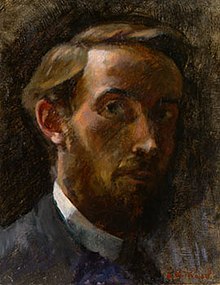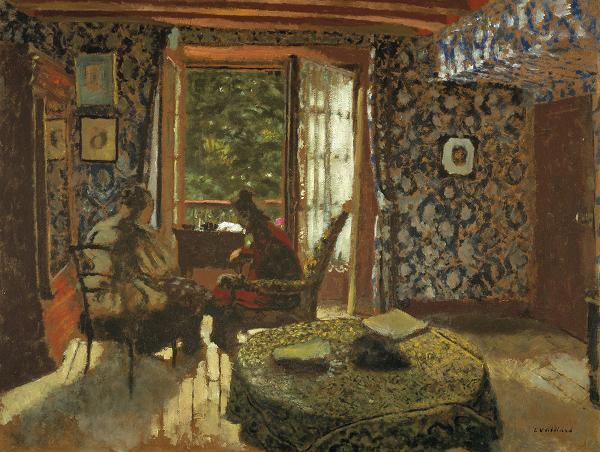Jean-Édouard Vuillard (French: [vÉ¥ijaÊ]; 11 November 1868 â€" 21 June 1940) was a French painter and printmaker associated with the Nabis.
Early life

Jean-Édouard Vuillard, the son of a retired captain, spent his youth at Cuiseaux (Saône-et-Loire); in 1878 his family moved to Paris in modest circumstances. After his father's death in 1884, Vuillard received a scholarship to continue his education. In the Lycée Condorcet Vuillard met Ker Xavier Roussel (also a future painter and Vuillard's future brother in law), Maurice Denis, musician Pierre Hermant, writer Pierre Véber, and Lugné-Poe.
Career

In 1885, Vuillard left the Lycée Condorcet. On the advice of his closest friend, Roussel, he refused a military career and joined Roussel at the studio of painter Diogène Maillart. There, Roussel and Vuillard received the rudiments of artistic training. In 1887, after three unsuccessful attempts, Vuillard passed the entrance examination for the École des Beaux-Arts. Vuillard kept a private journal from 1888â€"1905 and later from 1907â€"40.
Les Nabis and after
By 1890, the year in which Vuillard met Pierre Bonnard and Paul Sérusier, he had joined the Nabis, a group of art students inspired by the synthetism of Gauguin. He contributed to their exhibitions at the Gallery of Le Barc de Boutteville, and later shared a studio with fellow Nabis Bonnard and Maurice Denis. In the early 1890s, he worked for the Théâtre de l'Å'uvre of Lugné-Poe designing settings and programs.
In 1898 Vuillard visited Venice and Florence. The following year he made a trip to London. Later he went to Milan, Venice and Spain. Vuillard also traveled in Brittany and Normandy.
Vuillard first exhibited at the Salon des Indépendants of 1901 and at the Salon d'Automne in 1903. In the 1890s Vuillard met the brothers Alexandre and Thadée Natanson, the founders of La Revue Blanche, a cultural review. Vuillardʹs graphics appeared in the journal, together with Pierre Bonnard, Henri de Toulouse-Lautrec, Félix Vallotton and others. In 1892, on the advice of the Natanson brothers, Vuillard painted his first decorations ("apartment frescoes") for the house of Mme Desmarais. Subsequently he fulfilled many other commissions of this kind: in 1894 for Alexandre Natanson, in 1898 for Claude Anet, in 1908 for Bernstein, and in 1913 for Bernheim and for the Théâtre des Champs-Élysées. The last commissions he received date to 1937 (Palais de Chaillot in Paris, with Bonnard) and 1939 (Palais des Nations in Geneva, with Denis, Roussel and Chastel).
In his paintings and decorative pieces, Vuillard depicted mostly interiors, streets, and gardens. Marked by a gentle humor, they are executed in the delicate range of soft, blurred colors characteristic of his art. Living with his mother, a dressmaker, until the age of sixty, Vuillard was very familiar with interior and domestic spaces. Much of his art reflected this influence, largely decorative and often depicting very intricate patterns.
In 1912, Vuillard painted Théodore Duret in his Study, a commissioned portrait that signaled a new phase in Vuillard's work, which was dominated by portraiture from 1920 onwards.
Vuillard served as a juror with Florence Meyer Blumenthal in awarding the Prix Blumenthal, a grant given between 1919â€"1954 to young French painters, sculptors, decorators, engravers, writers, and musicians.
Vuillard died in La Baule in 1940.
"Le Grand Teddy" painting rediscovery
(See main article: The Grand Teddy tea-rooms paintings)
In 2013 the BBC television program Fake or Fortune? investigated a painting owned by British scriptwriter Keith Tutt, which both Tutt and the previous owners, Mr & Mrs Warren, believed to be a Vuillard. The vertical oval painting, which depicts a café scene, was thought to be one a group of three paintings commissioned from Vuillard in 1918 to decorate a new Parisian café, "Le Grand Teddy", named after American president Teddy Roosevelt. The main painting of the commission, a large horizontal oval work depicting a busy café interior (currently privately owned and kept in secure storage in Geneva, Switzerland) was at the time the only one of the three known to still exist and to have been fully confirmed as a genuine Vuillard. With assistance from art experts, the program undertook an exhaustive investigation and analysis of the Tutt painting, as well as carrying out extensive research to establish the painting's provenance. After submitting all the evidence to the secretive and highly conservative Wildenstein Institute in Paris, Tutt and the Fake or Fortune? team were delighted to learn that the Wildenstein Institute committee that reviewed the work had unanimously declared it to be genuine.
Selected exhibitions

- May 4, 2012 â€" September 23, 2012 Edouard Vuillard: A Painter and His Muses, 1890â€"1940 at The Jewish Museum in New York
- January 19, 2003 â€" April 20, 2003 Édouard Vuillard at National Gallery of Art in Washington, DC
- September 25, 2003 â€" January 4, 2004 Edouard Vuillard (1868-1940) at Musée d'Orsay in Paris
Selected works

- The Green Interior or Figure in front of a Window with Drawn Curtains (1891)
- Self Portrait (1892)
- Woman Sweeping (1892)
- Mother and Sister of the Artist (1893)
- The Seamstress (1893) at the Indianapolis Museum of Art
- The Yellow Curtain (1893)
- Married Life (1894)
- Under the Trees (from "The Public Gardens") (1894) at the Cleveland Museum of Art
- Chestnut Trees, a Cartoon for a Tiffany Stained-Glass Window (1894-1895), glue-based distemper on cardboard, mounted on canvas, 110 x 70 cm, Dallas Museum of Art
- At the Café (c.1897â€"99) at the Cleveland Museum of Art
- Woman in Blue With Child (Misia Natanson with Mimi Godebska, rue Saint-Florentin) (1899)
- Interior: Madame Vuillard and Grand-Mère Roussel at L'Étang-la-Ville (1900-1901), oil on cardboard, 53 x 70 cm, Dallas Museum of Art
- Le Déjeuner à Villeneuve-sur-Yonne (1902)
- Café Wepler (1908â€"10, reworked in 1912) at the Cleveland Museum of Art
- André Bénac (1936) at the Cleveland Museum of Art
- Le Grand Teddy (1918)
- At the Revue Blanche (Portrait of Félix Fénéon) (À la revue blanche - Portrait de Félix Fénéon) at the Guggenheim Museum
See also

- Pierre Bonnard
- Post-Impressionism
- Nabis
Notes

References

- Thompson, Belinda (1988). Vuillard. Oxford: Phaidon Press. ISBNÂ 978-0-7148-2955-5.Â
Further reading
- Vuillard, Édouard; Roger-Marx, Claude (1946). Vuillard: His Life & Work. Paul Elek. OCLC 1237747.Â
- Bonnard, Pierre (2001). Correspondence: Bonnard-Vuillard. Gallimard. ISBNÂ 978-2-07-076076-3.Â
- The Time of the Nabis, in French and German:
- Frèches-Thory, Claire; Perucchi-Petri, Ursula, eds. (1990). Les Nabis (in French). Paris: Flammarion. ISBN 2080109413.Â
- Frèches-Thory, Claire; Perucchi-Petri, Ursula, eds. (1993). Die Nabis: Propheten der Moderne (in German). Munich: Prestel. ISBN 3-7913-1969-8.Â
- Cogeval, Guy (2002). Vuillard â€" Master of the Intimate Interior. London: Thames & Hudson. ISBN 0-500-30109-3.Â
- Cogeval, Guy; Salomon, Antoine (2003). Vuillard: Critical Catalogues of Paintings and Pastels. Paris & Milan: Skila. ISBNÂ 8884911192.Â
- Roger-Marx, Claude (1990). The Graphic Work of Édouard Vuillard. San Francisco: Alan Wofsy Fine Arts.Â
- Vuillard, Édouard (1985). Édouard Vuillard. JPL Fine Arts. ASIN B00100R0HC.Â
External links

- Le Déjeuner à Villeneuve-sur-Yonne
- Vuillard's Biography and works
- Vuillard at Musée d'Orsay
- Vuilard at Joconde (the central database of the collections of the state museums of France)
- Sitting for Vuillard â€" The Bloch Family Portrait
- Pierre Bonnard: The Graphic Art at the Metropolitan Museum of Art - Exhibition catalog (December 2, 1989-Febriary 4, 1990), which contains material on Vuillard throughout
.jpg/360px-Edouard_Vuillard_-_The_Chestnuts_(1894-1895).jpg)
